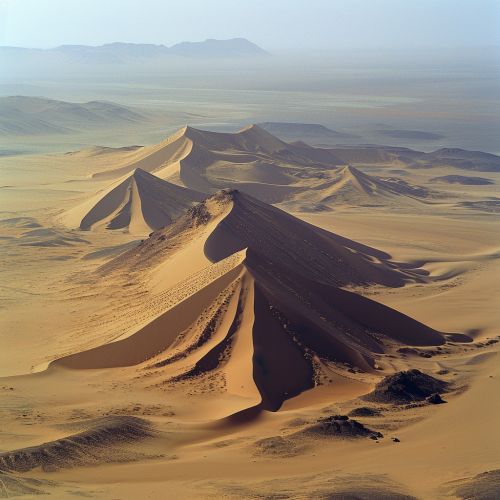Star dune
Introduction
A star dune is a type of aeolian landform that is characterized by a pyramidal shape with arms radiating from the center. This unique shape is formed by multidirectional wind regimes. Star dunes are the tallest of all dune forms and can reach heights of up to 300 meters. They are found in deserts across the world, including the Sahara, the Namib, and the Great Sand Dunes National Park in Colorado, USA.


Formation and Characteristics
The formation of star dunes is a complex process that involves the interaction of wind, sand, and time. Unlike other dune types, which are formed by a single prevailing wind direction, star dunes are created by winds that come from several directions. This multidirectional wind regime results in a complex, star-shaped dune with three or more arms extending from a central peak.
Each arm of a star dune, known as a "slipface," is a steep, sand-covered slope that is shaped by the wind. The wind causes sand to accumulate on the windward side of the dune, and when the slope becomes too steep, the sand slides down the slipface, causing the dune to grow. This process, known as saltation, is the primary mechanism of dune formation and growth.
Star dunes are typically isolated and occur in areas with a limited sand supply. They are slow-growing and can take thousands of years to form. Despite their slow growth, star dunes are the tallest of all dune forms and can reach impressive heights. The tallest star dune in the world is the Star Dune in the Great Sand Dunes National Park, which stands at approximately 750 feet tall.
Distribution and Locations
Star dunes are found in deserts across the world, particularly in areas with complex wind regimes. Some of the most notable locations include the Sahara Desert in Africa, the Namib Desert in Namibia, and the Great Sand Dunes National Park in the United States.
In the Sahara Desert, star dunes are a common feature and can reach heights of up to 300 meters. The Erg Chebbi dunes in Morocco and the Erg Chigaga dunes in Algeria are examples of star dune fields in the Sahara.
The Namib Desert is home to some of the world's oldest and tallest star dunes. The Sossusvlei dune field in Namibia is a UNESCO World Heritage Site and is renowned for its towering star dunes, some of which are over 300 meters tall.
In the United States, the Great Sand Dunes National Park in Colorado is home to the tallest star dunes in North America. The park's namesake, the Star Dune, is the tallest sand dune in North America and is a popular destination for hikers and sandboarders.
Ecological Significance
Despite the harsh conditions, star dunes play a significant role in desert ecosystems. They provide habitat for a variety of plant and animal species, many of which have adapted to the challenging desert environment.
Plants that grow on star dunes, known as psammophytes, have developed adaptations such as deep root systems and waxy leaves to survive in the sandy, nutrient-poor soil. These plants play a crucial role in stabilizing the dunes and preventing erosion.
Star dunes are also home to a variety of animal species, including insects, reptiles, birds, and mammals. Many of these animals have adapted to the desert environment by developing behaviors and physical characteristics that help them survive in the hot, dry conditions. For example, some insects and reptiles are able to burrow into the sand to escape the heat, while birds and mammals often become nocturnal to avoid the intense daytime temperatures.
